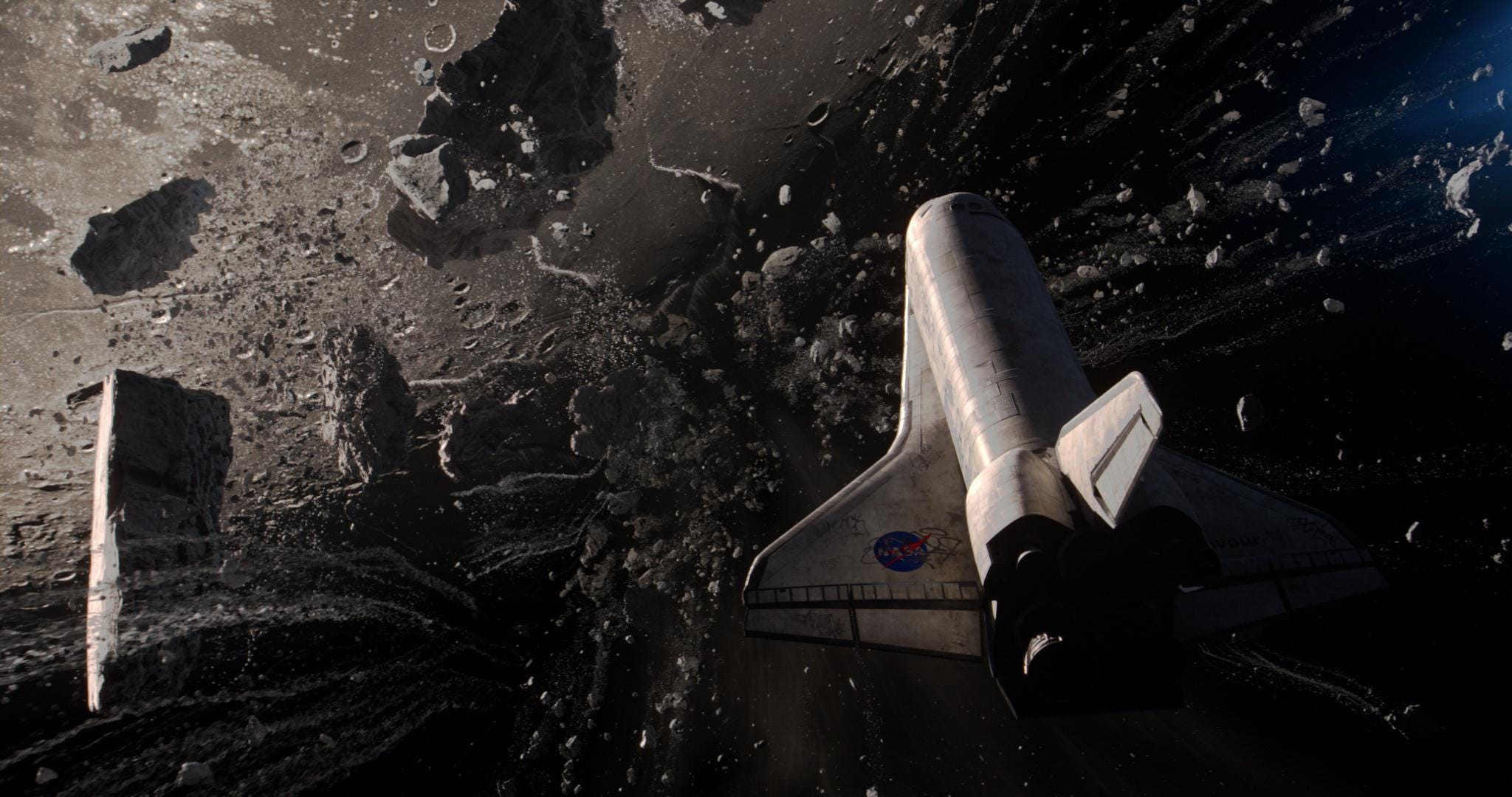
The Endeavor Space Shuttle dodging debris approaching the Moon’s surface in the sci-fi epic … [+]
Courtesy of Lionsgate
What would happen if the orbit of the Moon were to somehow decay and it crashed into Earth? There is more to the story in the new movie “Moonfall,” but that—in essence—is the catastrophe the story revolves around.
The movie stars Halle Berry and Patrick Wilson as astronauts, and John Bradley as a space hobbyist and conspiracy theorist as they team up to save the planet. As the Moon gets closer to Earth, the gravitational pull between the two bodies has a dramatic effect on the planet, resulting in various natural disasters and environmental catastrophes.
It’s a movie. It is fiction. So, there is room for artistic license and suspension of disbelief. I am not typically one to nitpick or hyper-analyze movies. Science fiction often relies on scientific principles that are purely theoretical, but even when creating pure fantasy, it generally makes a better story if it as least based on science that is possible. That said, there were scenes in this movie that seemed implausible.
Meet Mika McKinnon
Fortunately, I had an opportunity to speak with Mika McKinnon for a little reality check. Mika acted as a scientific advisor for “Moonfall”—providing feedback and guidance to help keep the movie grounded in plausible science. As a geophysicist and disaster researcher, she is an expert in understanding the science behind what would really happen if the orbit of the Moon were to somehow spiral down to Earth, and what the fallout of the resulting natural catastrophes would likely be on society.
Mika has an irrepressible curiosity about the many, many ways our universe can kill us. She holds a physics degree from the University of California at Santa Barbara where her research focused on the beginning and end of the universe. She then developed a more terrestrial focus on disasters while earning her graduate degree in geophysics at the University of British Columbia and has applied her expertise in disasters and science communication for Natural Resources Canada and the Federal Emergency Management Agency (FEMA), documenting lurking hazards, researching evidence-based protective actions guidance, and improving response plans for catastrophic events.
Recommended For You
She is currently engaged in Project ESPRESSO—exploring the effect of landslides on distant asteroids. Suffice it to say, Mika is more than qualified to assuage any doubt I had about the science behind “Moonfall.”
What If the Moon Fell?
I will do my best not to spoil the movie, but if you really don’t want to know anything about what happens you might want to stop here.
MOONFALL, Roland Emmerich, 2020/2021
Reiner Bajo
As the movie reaches its climax, the Moon is perilously close to Earth. The time it takes for the Moon to orbit the Earth is substantially shorter because the orbit is smaller, and the gravitational impact of the Moon is exponentially greater. All of that made sense to me, but I still questioned whether things would play out the way it is portrayed in the movie or if they leaned more heavily on the artistic license side of things.
“There’s a whole team of scientists involved in this who are doing all sorts of different bits and pieces of it and it included doing actual models of what happens when the Moon gets closer and how close can we get before we hit the Roche limit—the point where the gravitational stresses on it and the tidal stresses on it would rip it apart, and we would no longer have a moon we’d have rings like Saturn has,” explained Mika. “We really did actually use real science as the inspiration and the seed for this, of what sort of things would happen.”
She told me that the reality is that the Moon at one point was much closer to Earth and that it is actually getting farther and farther away over time—so most of the scientific study of the Moon is focused on the opposite problem of what happens if the Moon is too far. However, she noted that there are other places in the solar system where bodies have gotten closer that we can use as inspiration, along with mathematical models of how the interaction would work between the Earth and the Moon.
“We know the geophysics of Earth really well. We’ve spent an awfully long time mapping out the gravitational field of the Earth and mapping out the electromagnetic field of the Earth. We care about this planet a lot and we’ve been wandering around the surface for quite a while, which means we have some really good models of what sort of things would change and how. So I’d say that all of the disasters in the movie are science-inspired.”
Suspending Disbelief
Again, it’s a movie. It’s fiction. It is not a science documentary and you know that going in. Even the few questions I had were probably overthinking it to some extent, but I do like to believe that the science behind the story is at least theoretically plausible.
Speaking with Mika was awesome and I will happily defer to her knowledge and expertise. I almost want to watch the movie again now—to go back and re-examine some of the things I thought seemed farfetched and take a closer look through this new lens.
“Moonfall” opens in theaters today. Check it out for yourself and see what you think of the science. More importantly, though, just go enjoy the movie.






